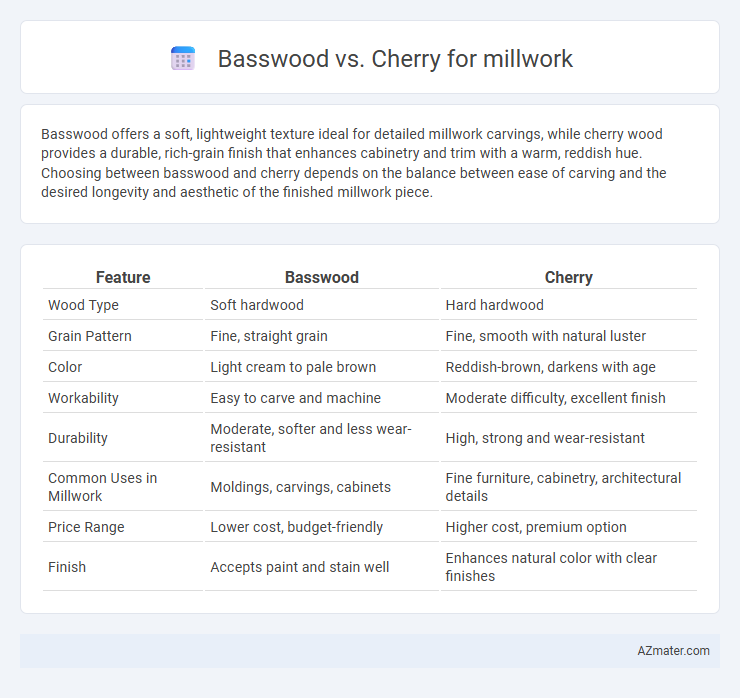Basswood offers a soft, lightweight texture ideal for detailed millwork carvings, while cherry wood provides a durable, rich-grain finish that enhances cabinetry and trim with a warm, reddish hue. Choosing between basswood and cherry depends on the balance between ease of carving and the desired longevity and aesthetic of the finished millwork piece.
Table of Comparison
| Feature | Basswood | Cherry |
|---|---|---|
| Wood Type | Soft hardwood | Hard hardwood |
| Grain Pattern | Fine, straight grain | Fine, smooth with natural luster |
| Color | Light cream to pale brown | Reddish-brown, darkens with age |
| Workability | Easy to carve and machine | Moderate difficulty, excellent finish |
| Durability | Moderate, softer and less wear-resistant | High, strong and wear-resistant |
| Common Uses in Millwork | Moldings, carvings, cabinets | Fine furniture, cabinetry, architectural details |
| Price Range | Lower cost, budget-friendly | Higher cost, premium option |
| Finish | Accepts paint and stain well | Enhances natural color with clear finishes |
Introduction to Basswood and Cherry for Millwork
Basswood offers a fine, even grain and soft texture, making it ideal for detailed millwork and carving, with consistent workability and minimal splintering. Cherry wood features a rich color that darkens with age, combined with a smooth grain that enhances its aesthetic appeal in high-end millwork and cabinetry. Both woods provide durability and are favored for their ease of finishing, but basswood is preferred for intricate designs while cherry is valued for its natural beauty and strength.
Physical Properties Comparison
Basswood features a fine, even grain with a light, creamy color and is known for its softness and ease of carving, making it ideal for intricate millwork details. Cherry wood exhibits a smooth, fine grain with a rich reddish-brown hue that deepens over time, offering greater hardness and durability compared to basswood, which enhances its resistance to wear in millwork applications. The Janka hardness rating for cherry is around 950, significantly higher than basswood's 410, indicating cherry's superior strength and suitability for high-traffic areas or structural elements in millwork.
Appearance and Grain Differences
Basswood exhibits a light cream to pale yellow color with a fine, even texture, making it ideal for painted millwork due to its smooth, uniform grain. Cherry, known for its rich reddish-brown hue that deepens with age, shows a distinct, straight grain pattern with occasional waves or curls, offering a warm and elegant appearance for stained or natural finishes. The contrasting grain and color profiles make basswood preferable for detailed, painted projects, while cherry is favored where natural wood beauty and color depth are desired.
Workability and Machinability
Basswood offers superior workability and machinability for millwork due to its soft, fine-grained texture, allowing for easy cutting, shaping, and sanding without splintering. Cherry, while harder and denser, provides a smooth finish but requires sharper tools and slower machining speeds to avoid burning or tear-out. Both woods excel in precision millwork, but basswood's ease of handling makes it ideal for intricate detailing and carving tasks.
Durability and Hardness
Basswood, known for its softness with a Janka hardness of around 410, offers ease of carving and shaping but lacks durability for heavy-use millwork. Cherry wood ranks higher in hardness, approximately 950 on the Janka scale, providing better resistance to dents and wear, making it suitable for durable, high-traffic applications. Its natural aging process develops a rich patina, enhancing both strength and aesthetic value over time.
Cost and Availability
Basswood offers a more affordable option for millwork compared to cherry, which tends to be pricier due to its rich color and grain. Basswood is widely available and sourced sustainably, making it a cost-effective choice for large projects and intricate carvings. Cherry wood, while less abundant, commands higher prices due to its desirable aesthetics and durability, often leading to longer lead times and limited supply.
Finishing and Staining Characteristics
Basswood offers a smooth, fine grain that absorbs stain evenly, making it ideal for achieving consistent finishes and vibrant colors in millwork. Cherry features a rich, natural reddish-brown tone that deepens over time, requiring careful stain application to avoid blotchiness and to enhance its warm, elegant appearance. Both woods accept paint well, but basswood's uniform texture makes it preferable for detailed millwork requiring precise staining and finishing.
Best Uses in Millwork Applications
Basswood excels in millwork applications requiring intricate carving and detailed moldings due to its fine, even grain and soft texture, making it ideal for decorative trims and cabinetry components. Cherry wood offers superior durability and rich, warm coloration, preferred for high-end furniture, paneling, and millwork that demands both strength and aesthetic appeal. Selecting between basswood and cherry depends on balancing the need for detailed work with the desired finish longevity and visual impact in millwork projects.
Environmental Impact and Sustainability
Basswood, known for its rapid growth rate and widespread availability in North America, offers a more sustainable option for millwork due to its lower environmental footprint and ability to regenerate quickly compared to cherry. Cherry wood, while prized for its rich color and durability, grows slower and often requires more intensive harvesting practices, resulting in a higher carbon footprint and less sustainable impact over time. Choosing basswood reduces deforestation risks and supports eco-friendly millwork projects focused on sustainability and resource conservation.
Choosing the Right Wood for Your Project
Basswood offers a lightweight, fine-grained texture ideal for detailed millwork, making it perfect for intricate carvings and painted finishes. Cherry wood provides a rich, warm tone with excellent durability and a smooth grain, enhancing natural wood projects that benefit from a polished, elegant look. Selecting between basswood and cherry depends on the desired finish, durability requirements, and aesthetic preferences for your millwork project.

Infographic: Basswood vs Cherry for Millwork
 azmater.com
azmater.com